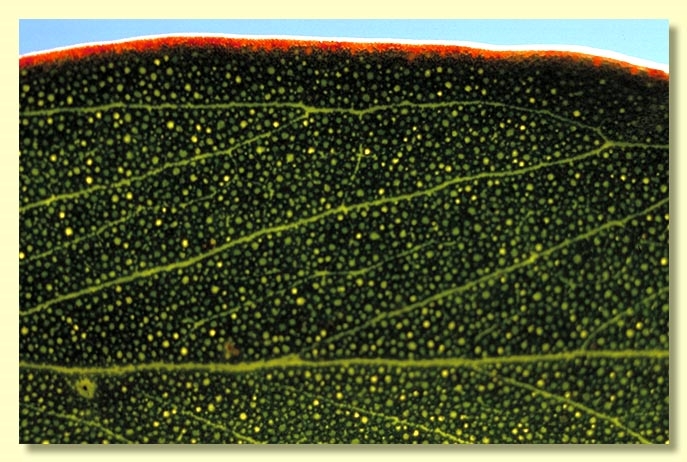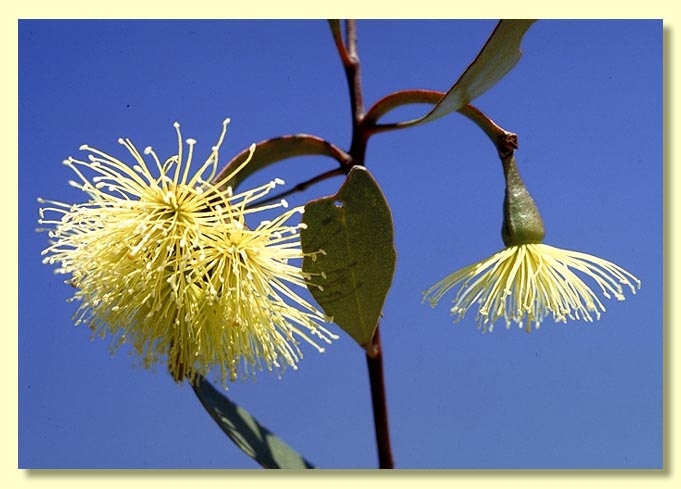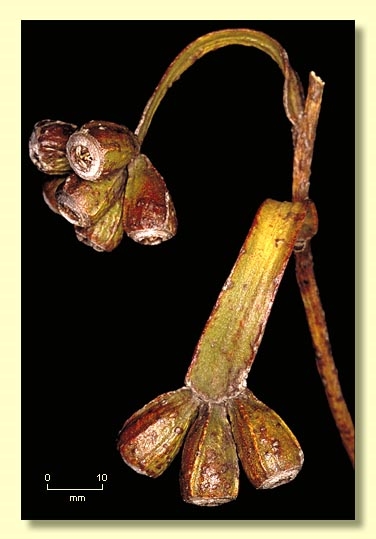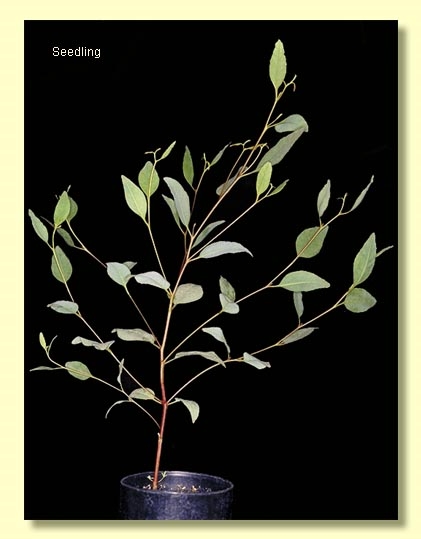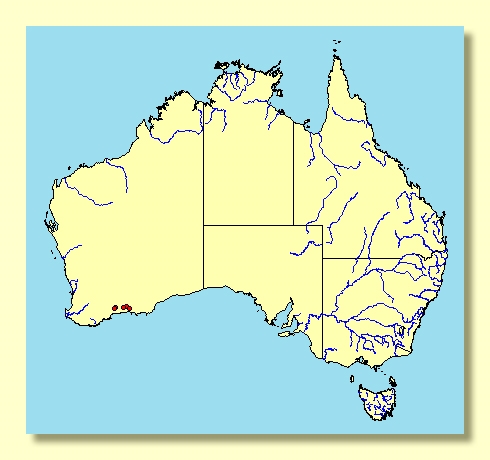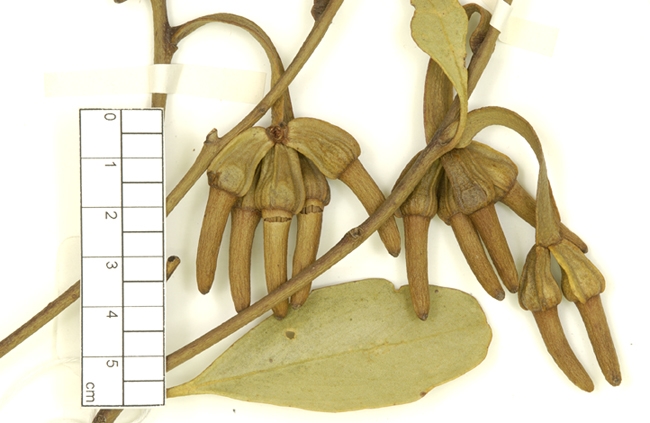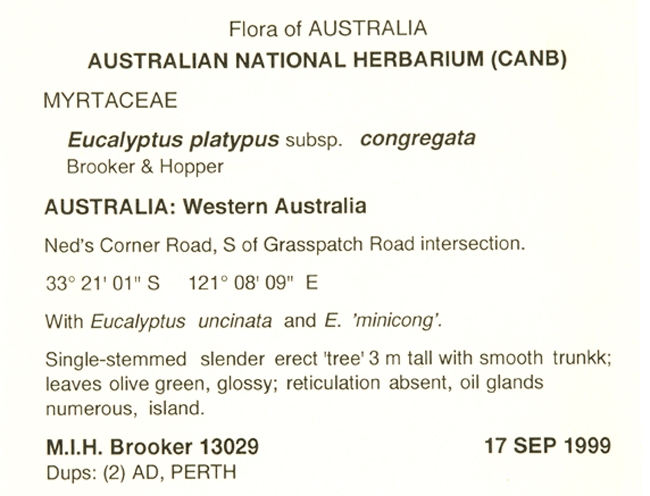Euclid - Online edition
Eucalyptus platypus subsp. congregata
Eucalyptus | Symphyomyrtus | Bisectae | Glandulosae | Erectae | Abundae
Bark smooth throughout, blackish to grey-green over coppery brown to pinkish grey.
Branchlets have oil glands in the pith.
Juvenile growth (coppice or field seedlings to 50 cm): stems rounded in cross-section; juvenile leaves always petiolate, alternate, elliptic to ovate or almost orbicular, 4–5.5 cm long, 2.5–3.5 cm wide, margin indented, apex pointed to rounded. Lowest parts of stem and the lower leaves scabrid.
Adult leaves alternate, thick, held erect, petioles 0.5–1.7 cm long; blade orbicular to very broadly elliptical, 4–8.2 cm long, 1.5–3 cm wide, base tapering to petiole, margin entire, crenulate or distantly indented, apex emarginate to rounded, concolorous, green, glossy, surface appearing "glazed", side-veins acute or obscure, reticulation sparse or not visible, intramarginal vein remote from margin, oil glands numerous, slightly irregular, island.
Inflorescence axillary unbranched, spreading to pendulous, peduncles broadly flattened, 2.7–7 cm long at mature bud/flowering stage; buds 7 per umbel, sessile or very shortly pedicellate (pedicels 0–0.3 cm long). Mature buds elongated (2.9–3 cm long, 0.6–0.9 cm wide) with hypanthium wider than the operculum at the join, scar present (outer operculum lost very early), inner operculum horn-shaped, ca twice the length of the 4-ridged hypanthium, stamens erect, arranged in ca 3 whorls on a conspicuously broad staminophore, anthers oblong, versatile, dorsifixed, dehiscing by longitudinal slits, style long and straight, stigma blunt to slightly dilated, locules 4 or 5, the placentae each with (?4 or) 6 vertical rows of ovules. Flowers usually pale yellow.
Fruit down-turned, usually sessile, rarely shortly pedicellate to 0.1 cm long, obconical with 4 longitudinal ridges, 1.2–1.9 cm long, 0.9–1.3 cm wide, staminophore broad, disc descending, valves 4 or 5, held at about rim level.
Seeds blackish brown, 0.7–2 mm long, ovoid to flattened-ovoid, dorsal surface shallowly and clearly reticulate, hilum ventral.
Cultivated seedlings (measured at node 10): cotyledons Y-shaped (bisected); stems rounded in cross-section, scabrid; leaves always petiolate, opposite for ca 5 nodes then alternate, ovate to elliptical, 3.5–5.5 cm long, 1.5–3 cm wide, dull, green, lamina scabrid on margin and underside.
Flowering has been recorded in February.
Eucalyptus platypus is a mallet or marlock species endemic to Western Australia, of south coastal and subcoastal areas, from Gnowangerup and Tambellup north of Albany east towards Salmon Gums and Speddingup, often in dense pure stands on hard clayey soils. The bark is smooth, sometimes shiny, and the adult leaves glossy, dark green to olive green.
Eucalyptus platypus is most likely to be confused with E. utilis, which differs in having narrower adult leaves mostly lanceolate, not elliptical to orbicular, and bud clusters on spreading to erect, not down-turned, peduncles. E. platypus usually occurs on heavy soils, E. utilis on coastal sand-dunes. E. platypus is similar in habit to E. vesiculosa but differs in having buds with smooth, not very warty opercula, erect, not inflexed, stamens and yellow-green (rarely pink) flowers not red. Eucalyptus nutans, restricted to coastal and near coastal sites east of Albany, was for many years included in E. platypus being similar in habit, adult leaves and peduncles but differs in having buds with a much shorter operculum more or less equal to the hypanthium in length, red/pink flowers and fruit with 5(6) valves.
There are two subspecies:
E. platypus subsp. platypus
This form is the widespread mallet or marlock with predominantly round leaves and peduncles 1.3-4(5) cm long. It occurs from Gnowangerup and Tambellup east towards Speddingup.
E. platypus subsp. congregata
This form is a mallet or marlock with predominantly elliptical leaves and peduncles 2.7-7 cm long. It is found from north of Ravensthorpe east to near Salmon Gums.
Operculum length relative to hypanthium
Flower colour
Fruit width cm
Adult leaf shape
nutans
operculum = hypanthium
red or pink-red
1.4–1.9
elliptic, oblong, suborbicular
platypus (both subspp.)
operculum 1.5–3 times hypanthium
pale yellow-green, rarely red
0.8–1.3
elliptic to orbicular
utilis
1.2–2.3 times hypanthium
creamy white
0.7–1.0
ovate to lanceolate
In the classification of Brooker (2000) Eucalyptus platypus belongs in Eucalyptus subgenus Symphyomyrtus section Bisectae subsection Glandulosae because the buds have an operculum scar, cotyledons are bisected and branchlets have oil glands in the pith. Within this very large subsection, E. platypus is only closely related to E. nutans and E. utilis, having similar general habit, four-angled buds in clusters of seven on conspicuous broadly flattened and often long peduncles, erect stamens, and highly glandular leaves with indented margins.
subsp. congregata: Latin congregatus, to flock together, referring to the pure stands of this subspecies.



